
Nelson's Column
Nelson's Column is a monument to Lord Nelson in Trafalgar Square in Charing Cross, London.
Origins and design[]
The column was built between 1840 and 1843 to commemorate Admiral Horatio Nelson's death at the Battle of Trafalgar in 1805. The 5.5 m (18 ft) statue of Nelson stands on top of a 51.5 m (170.7) granite column. The statue faces south looking towards the Admiralty (Wikipedia page [1]), with the Mall on his right flank, where Nelson's ships are represented on the top of each flagpole[citation needed]. The top of the Corinthian column (based on one from the Temple of Mars Ultor in Rome) is decorated with bronze acanthus leaves cast from British cannon. The square pedestal is decorated with four bronze panels, cast from captured French guns, depicting Nelson's four great victories.
The monument was designed by architect William Railton [2] in 1838, and built by the firm Peto & Grissell. Railton's original 1:22-scale stone model is exhibited at the National Maritime Museum in Greenwich, London. The sandstone statue at the top was sculpted by E.H. Baily (Wikipedia page [3]), a member of the Royal Academy; a small bronze plaque crediting him is at the base of the statue. The four bronze panels around the pedestal were undertaken by the sculptors Musgrave Watson [4], John Ternouth [5], William F Woodington [6], and John Edward Carew [7]. The entire monument was built at a cost of 47,500 pounds, or 3.5 million pounds in 2004 terms (roughly $6.1 million US).

Lord Nelson, atop the column.
The four lions, by Sir Edwin Landseer[8], at the column's base were added in 1867.
20th century[]
In 1925 a Scottish confidence trickster, Arthur Furguson, "sold" the landmark to an unknowing American claiming it was for sale to pay off Britain's war loan to the United States. (He also "sold" Big Ben and Buckingham Palace.)
The Column also had some symbolic importance to Adolf Hitler. If Hitler's plan to invade Britain, Operation Sealion, had been successful, he had planned to move the Column to Berlin.
Climbs[]
The Column has been climbed on several occasions as a publicity stunt to draw attention to a social or political cause. Ed Drummond made the first such climb in 1978 for the Anti-Apartheid Movement, making use of the lightning conductor on route. On 31 March 1988 Joe Simpson and John Stevenson climbed the column as part of a Greenpeace Campaign against Acid Rain. On 14 June 1992 it was climbed by Martin Cotterrel, Joe Simpson and John Stevenson on behalf of Greenpeace to protest about The first Earth Summit meeting in Brazil. On 13 April 1995 Johnny Dawes free-climbed Nelson's Column with Noel Craine, Jerry Moffat and Simon Nadin, and graded the climb as "E6 6b/5a". The protest this time was on behalf of Survival International to publicize the plight of Canada's Inuit people. On 13 May 1998 the Column was climbed again by Al Baker, Peter Morris and John Cunningham on behalf of Greenpeace to protest against Old growth logging activity in British Columbia. In May 2003 BASE jumper and stuntman Gary Connery parachuted from the top of the column to draw attention to the Chinese occupation of Tibet.
John Noakes of the BBC TV children's programme Blue Peter climbed the column in the late 1970s.
Refurbishment[]
The column was refurbished in 2006, during which time it was scaffolded from top to bottom for access. Steam cleaning was used together with gentle abrasives to minimise any harmful impact on the brass and stonework. The work was performed by David Ball Restoration Ltd. of South London. The £420,000 cost was covered by Zurich Financial Services, which advertised on the scaffolding for the duration of the work. Before restoration began, laser surveys were taken during which it was found that the column was significantly shorter than the usually quoted 56 m (185 ft). In fact, it measures 50 m (169ft 5 in) from the bottom of the first step on the pedestal to the tip of the admiral's hat.
| This page uses Creative Commons Licensed content from Wikipedia (view authors). That Wikipedia page probably contains more information. |